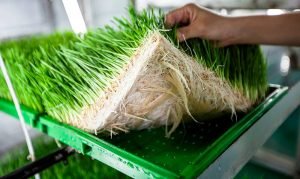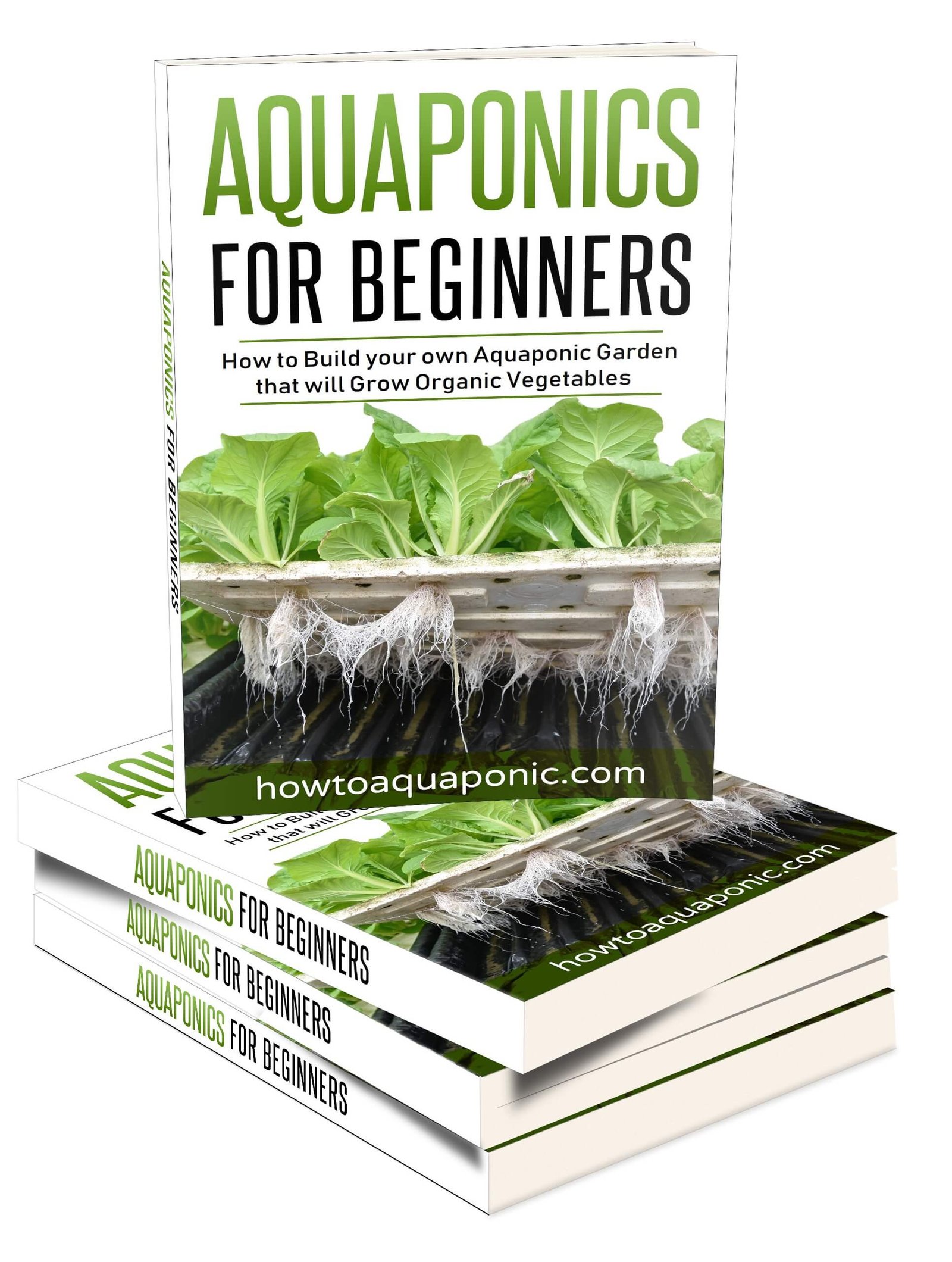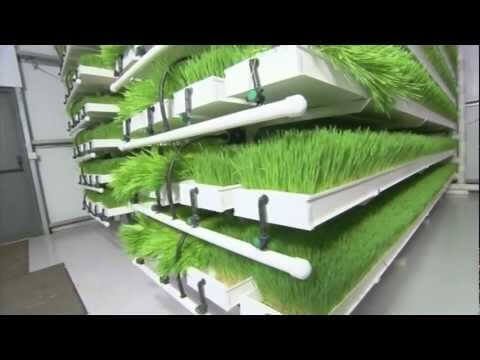Wheatgrass is not the first thing you think of when considering starting an aquaponics system. However, there are many reasons why wheatgrass aquaponics makes sense; and it’s not as difficult as you may think to grow it!
You may have heard of wheatgrass being referred to as fodder, this is due to its link with animals and their food. But wheatgrass can also be eaten by humans and actually has an array of health benefits, including:
- Reduction of cholesterol.
- Helps regulate blood sugar levels.
- Can prevent against cancer.
- May promote weight loss.
- Could alleviate inflammation.
What is wheatgrass?
 Wheatgrass is simply the first leaves of the wheat plant. These can be harvested as the plant sprouts before it becomes wheat. It is allowed to grow longer than either of its cousins, wheat malt or barley grass.
Wheatgrass is simply the first leaves of the wheat plant. These can be harvested as the plant sprouts before it becomes wheat. It is allowed to grow longer than either of its cousins, wheat malt or barley grass.
Once the grass is harvested it can be used as it is, fresh. Alternatively, it can be freeze-dried and then becomes part of a nutritional supplement or even wheatgrass juice. This has become a popular option as there are no many health benefits surrounding this product.
 I have written a book that contains all the information you need to get started with aquaponics.
I have written a book that contains all the information you need to get started with aquaponics.
Don’t be the person that makes painful mistakes during your first aquaponics build!
It has 265 pages filled with information about aquaponics. It’s available in paperback or eBook format.
You can buy it here on Amazon.com
Why should you grow wheatgrass?
Aside from the obvious, although still some unproven health benefits to humans. A wheatgrass aquaponics system will give you a plentiful supply of this substance for your animals. Horses, rabbits, chickens, and you.
If it is as healthy as some people suggests then you may as well grow it for nearly nothing in your own wheatgrass aquaponics system. That’s a better way of feeding your animals and even offering yourself some health benefits.
Is wheatgrass a complete food source for animals?
You may be surprised to find that the answer is yes. Wheatgrass is packed full of vitamins, minerals, and other essential nutrients for animals. It is actually very good for the digestive system of any animal, helping them to digest it and other foods efficiently.
How to grow wheatgrass in aquaponics
Growing wheatgrass in your aquaponics system doesn’t need to be difficult. You will need to have your system established first, with you fish settled and ready to feed your wheatgrass. You can then follow these steps:
Step 1 – Soak seeds for 8 hours
You should take a bowlful of water from your aquaponics system, to ensure the water quality is maintained. Then place the wheatgrass seeds into the bowl, making sure they are all submerged.
Leave this for at least 8 hours.
Step 2 – Drain the water and keep seeds covered for 8 hours
You can now drain the water, it is not necessary or advisable to put it back into your aquaponics system. Cover the seeds up to ensure they stay moist and in the dark for the next 8 hours.
Step 3 – After the 8 hours, rinse the seeds again.
You should now rinse the seeds with a little more water from your aquaponics system; just like you did in step 1.
Step4 – Do step two and three a few times
Once the eight hours have passed you can repeat steps 2 and 3. Then, inspect the seeds to see if there is a white tail on them. If not, you’ll have to repeat steps 2 and 3 again.
It normally takes 3 or 4 repeats before you’ll see the white tail.
Step 5 – Place seeds in a tray that is able to get rid of moisture
Your seeds are now nearly ready to be introduced to your aquaponics system. The best idea is to use a plastic grow tray and drill lots of small holes in the bottom.
You can then put all your seeds in the tray, laid out to help them dry. The trays should be left somewhere for approximately 8 hours, giving the seeds time to dry and the moisture the opportunity to escape.
Step 6 – Grow Beds
The next step is to get a fresh tray, with a few small holes in and lay a sheet of hemp grow bed material in the bottom of it. This will prevent the seeds from falling through into the water below or becoming too saturated.
Step 7 – Cover The Tray
Cover the tray with a linen cloth that will stop any light getting to the seeds. This is an important part of germination. During this time the white shoots should remain visible.
You’ll need to keep them covered for 48 hours.
Step 8 – Remove the cloth and water 2 times a day for 7 days. The shoot will now turn green.
Now remove the cloth and gently place the tray onto your aquaponics trough, as a floating raft. The water will come in from the bottom and moisten the hemp pad.
Make sure the pad remains moist but the seeds are not saturated all the time. After 7 days the white shoot should have turned green.
Step 9 – Harvest Time
You can then watch and maintain the water quality while the shoots start to grow. It shouldn’t take long for them to reach 5 or 6 inches tall. At this stage, the wheatgrass splits at the top of the shoot and you know they are ready to harvest.
It’s that simple!
Seed density for wheatgrass
Getting the seed density right is essential to obtaining a balance between maximum crop production and a decent crop.
The right ratio is between 6 and 8 cups of seed per 10” x 20” tray.

Moldy wheatgrass can be harmfull
This is an important note that you need to be aware of. Wheatgrass is grown in a damp environment, if it isn’t dried properly before being stored it will attract mold, and this is harmful to your animals.
Wheatgrass Aquaponics: The Final Say
Wheatgrass is a great alternative to the traditional crops and flowers that are grown with aquaponics systems. It saves you money and takes very little time and effort. If you haven’t tried wheatgrass aquaponics yet, then now is the time you should.
 I have written a book that contains all the information you need to get started with aquaponics.
I have written a book that contains all the information you need to get started with aquaponics.
Don’t be the person that makes painful mistakes during your first aquaponics build!
It has 265 pages filled with information about aquaponics. It’s available in paperback or eBook format.
You can buy it here on Amazon.com

Nick loves building, managing and giving others advice on aquaponics. He created this website to do just that. He is the author of Aquaponics for beginners. If you got a question contact him here or read more on the about page here.
